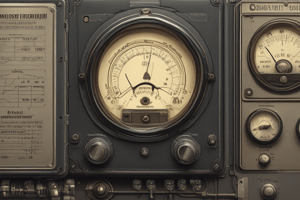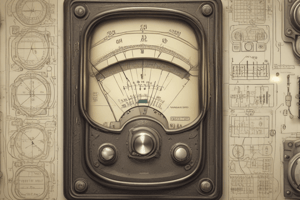Podcast
Questions and Answers
What is the relationship between the deflection and the power flowing through the Electrodynamometer Wattmeter?
What is the relationship between the deflection and the power flowing through the Electrodynamometer Wattmeter?
- The deflection is not related to the power.
- The deflection is directly proportional to the power. (correct)
- The deflection is proportional to the square of the power.
- The deflection is inversely proportional to the power.
How is the current coil designed in the Electrodynamometer Wattmeter?
How is the current coil designed in the Electrodynamometer Wattmeter?
- It carries approximately 40 Amperes.
- It carries approximately 30 Amperes.
- It carries approximately 10 Amperes.
- It carries approximately 20 Amperes. (correct)
What is the purpose of the resistor connected in series with the moving coil?
What is the purpose of the resistor connected in series with the moving coil?
- To increase the voltage supply.
- To increase the current flow.
- To reduce the magnetic flux.
- To control the flow of the current. (correct)
What type of control system is used in the Electrodynamometer Wattmeter?
What type of control system is used in the Electrodynamometer Wattmeter?
What is the effect of air friction in the Electrodynamometer Wattmeter?
What is the effect of air friction in the Electrodynamometer Wattmeter?
What type of scale is used in the Electrodynamometer Wattmeter?
What type of scale is used in the Electrodynamometer Wattmeter?
What is the primary advantage of electrodynamometer instruments over moving iron types?
What is the primary advantage of electrodynamometer instruments over moving iron types?
What is the primary advantage of moving iron type power factor meters?
What is the primary advantage of moving iron type power factor meters?
What is the unique feature of the three-phase electrodynamometer type power factor meter?
What is the unique feature of the three-phase electrodynamometer type power factor meter?
What is the purpose of the series resistance in the three-phase electrodynamometer type power factor meter?
What is the purpose of the series resistance in the three-phase electrodynamometer type power factor meter?
What is the configuration of the fixed coil in the three-phase moving iron type power factor meter?
What is the configuration of the fixed coil in the three-phase moving iron type power factor meter?
What is the purpose of the sector-shaped vanes and pointer in the three-phase moving iron type power factor meter?
What is the purpose of the sector-shaped vanes and pointer in the three-phase moving iron type power factor meter?
What is the primary benefit of ensuring compliance with IEC standards for electrical equipment?
What is the primary benefit of ensuring compliance with IEC standards for electrical equipment?
What is the primary purpose of training and certification for crew members responsible for switchgear and switchboards on ships?
What is the primary purpose of training and certification for crew members responsible for switchgear and switchboards on ships?
Which of the following regulations may govern electrical installations on ships?
Which of the following regulations may govern electrical installations on ships?
Why are special starting procedures required for high-torque induction motors?
Why are special starting procedures required for high-torque induction motors?
What is the primary reason for ensuring motors accelerate quickly up to the predetermined speed?
What is the primary reason for ensuring motors accelerate quickly up to the predetermined speed?
What type of starters can be used to gradually start high-torque induction motors?
What type of starters can be used to gradually start high-torque induction motors?
What is the primary function of pump control?
What is the primary function of pump control?
What is the purpose of a slip clutch in the Dreggen engine room crane hoisting machinery?
What is the purpose of a slip clutch in the Dreggen engine room crane hoisting machinery?
What type of motor is used in the Engine room crane control?
What type of motor is used in the Engine room crane control?
Why is a rack and pinion drive incorporated in the travel machinery of the Engine room crane?
Why is a rack and pinion drive incorporated in the travel machinery of the Engine room crane?
What is the function of the chain collection box in the Dreggen engine room crane hoisting machinery?
What is the function of the chain collection box in the Dreggen engine room crane hoisting machinery?
What type of starter can be used to automatically operate a pump?
What type of starter can be used to automatically operate a pump?
What is the primary purpose of the service factor in generator protection?
What is the primary purpose of the service factor in generator protection?
What is the main reason for implementing overload current protection in generators?
What is the main reason for implementing overload current protection in generators?
What is the function of relays in over-current protection?
What is the function of relays in over-current protection?
Which type of trip is commonly used in miniature circuit breakers (MCBs)?
Which type of trip is commonly used in miniature circuit breakers (MCBs)?
What is the primary principle of operation of a thermal trip?
What is the primary principle of operation of a thermal trip?
What is the function of microprocessors in electronic over-current relays?
What is the function of microprocessors in electronic over-current relays?
Flashcards are hidden until you start studying
Study Notes
Power Factor Meters
- There are two types of power factor meters: Electrodynamometer and Moving Iron type
- Electrodynamometer type meters are more accurate, but Moving Iron type meters are cheaper, simpler, and more robust
- Moving Iron type meters have scales that extend 360 degrees, and all coils are fixed, eliminating ligaments
Three-Phase Electrodynamometer Type Power Factor Meter
- Only useful for balanced loads
- Two moving coils are placed at an angle of 120 degrees to each other
- Each coil has a series resistance and is connected to two different phases of the supply circuit
- No phase splitting is required, as the required phase displacement can be obtained from the supply itself
Three-Phase Moving Iron Type Power Factor Meter
- Has a fixed coil connected in series with a high resistance across one pair of lines
- Coil is in the center of three fixed coils, each connected to lines 1, 2, and 3 respectively
- Compliance with IEC standards ensures electrical equipment meets internationally accepted technical specifications
Training and Certification Requirements
- Crew members operating, maintaining, or repairing switchgear and switchboards on ships must receive training and certification to ensure competency and compliance with safety protocols
- National and regional regulations, such as USCG regulations and EU directives, govern electrical installations on ships
Starters for Alternating Current Motors
- Special high-torque induction motors require careful starting procedures to prevent damage
- Soft starters can be used to gradually start motors, ensuring smooth acceleration and reduced stress on motor windings
- Approximate full-load currents for 3-phase motors of average efficiency must be considered
Over-Current Protection
- Generators require circuit breakers for long-time delay over-current protection, limited to 15% above their full-load or overload rating
- Overload current can result from increased switchboard loads, unnoticed operation of large systems, or serious faults
- Over-current protection is achieved through relays, breaker overload current trips, and instantaneous short-circuit current tripping
Types of Trip
- Electromagnetic Trip: uses a solenoid to operate a 'trip' switch
- Thermal Trip: uses a bimetallic strip to trip the circuit breaker
- Electronic Trip: converts current into a proportional voltage and uses microprocessors to process current signals
Construction of Electrodynamometer Wattmeter
- Fixed coil is connected in series with the load and is divided into two parts for easy construction
- Moving coil is connected parallel with the supply voltage and has a pointer mounted on it
- Temperature increases when current flows through the coil, so a resistor is connected in series to control the flow of current
Control and Damping
- Control provides controlling torque onto the instrument, with gravity control and spring control being the two types
- Electrodynamometer wattmeters use a spring control system to help the pointer movement
- Damping reduces the pointer movement, with air friction being used to produce damping torque
Scales and Pointers
- Linear scale is used, as the moving coil moves linearly
- Short circuit protection must be provided by fuses or a circuit breaker on the supply side of the starter
Remote Control Pump Control
- Pump control refers to changing how pumps operate using pump controllers and actuators
- Direct-on-line Starter can be automatically operated using a float switch
Engine Room Crane Control
- Engine room crane is an indispensable piece of equipment on a ship
- Various types of cranes exist, ranging from simple two-motor-single-speed type to three-motor-dual-speed type
- Speed control of standard induction motors can be achieved using special-purpose motor and electronic cards
Studying That Suits You
Use AI to generate personalized quizzes and flashcards to suit your learning preferences.





